The western hills of Barolo
This trail winds through more than 37 kilometres of breathtaking montainous landscape, allowing hikers spectacular and rousing views of valleys, rivers and the rich vineyards of Barolo.
Starting from the city of Alba, taking the orbital road in the direction of Barolo, we shall exit at Cantina di Roddi to reach the first leg of our tour: Roddi. Located in an amazing position, on a hogback dominating the valley near Alba, Roddi is a medieval hamlet perched around its castle, according to a framework typical of the hilly landscape of Langhe. The village is in a position overlooking the Tanaro Valley and appears in several documents dating back to the year 1000 A.D., but the origins are even older, dating back to the Roman period. The name, of Celtic origins, probably comes from “raud”, or “rod”, river, and clearly refers to Tanaro, which flows through the underlying valley. As proven by some Latin funeral shrines, the place was already inhabited in the Roman period: in fact there was the Castrum Raudhium, an important and strategic settlement, where in 101 B.C. the Consul Mario defeated the Cimbri in the Battle of the Raudine Plain and, in 402 A.D., General Stilicone won against the Goths of Alaric in the Battle of Pollentia. The hamlet belonged to the monks of Saint Benedict who built an Abbey dedicated to Saint Stephen. The Abbey was surrounded by many fields but has now totally disappeared. 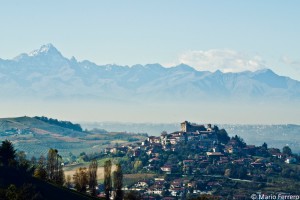
The trail goes further, running along the river Tanaro, which divides Roero (on the left bank) from Langhe (on the right bank) in the direction of Verduno, another important wine producing centre, famous today thanks to a particular red wine produced in its municipal territory, Pelaverga. 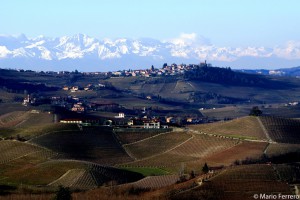 The village, with Celtic origins, was considered a holiday place by the noble families of Alba Pompeia and Pollentia. Around the year AD 1000, it was a property of the Bishop of Asti; some years later, in the year 1026, it became property of the Abbey of Breme in the Lomellina region. In the following years, inheritances and dowries dismembered these properties more and more until 1631 when the hamlet was included in the Savoy Dukedom and became one of the most important and prestigious residences of the Savoy family. In 1837, King Charles Albert gave to a famous oenologist of that time, Francesco Staglieno, the property management with the task to transform it into a perfect wine producing farm. The main attraction of this area is the whole village itself, with the warm shades of the cotto tiles, the fine and mild polychromies of the walls, the pleasant games of light and the steep streets. The near point is, for sure, the panoramic viewpoint, a garden located on top of the village, a panoramic terrace overlooking the hills of Langhe and Roero that seems to embrace them all. Other lively spots are the small squares and panoramic points of the historical centre, where you can also find nice bistros and gastronomic corners. Another must see is the striking Piazza Don Borgna where the Castle stands out, an amazing building signed by the famous architect Juvarra. Verduno is today a village dedicated to art. Since the 1960s, it was attended by painters such as Lucio Fontana and Pinot Gallizio and is still lively thanks to the activity of many young artists.
The village, with Celtic origins, was considered a holiday place by the noble families of Alba Pompeia and Pollentia. Around the year AD 1000, it was a property of the Bishop of Asti; some years later, in the year 1026, it became property of the Abbey of Breme in the Lomellina region. In the following years, inheritances and dowries dismembered these properties more and more until 1631 when the hamlet was included in the Savoy Dukedom and became one of the most important and prestigious residences of the Savoy family. In 1837, King Charles Albert gave to a famous oenologist of that time, Francesco Staglieno, the property management with the task to transform it into a perfect wine producing farm. The main attraction of this area is the whole village itself, with the warm shades of the cotto tiles, the fine and mild polychromies of the walls, the pleasant games of light and the steep streets. The near point is, for sure, the panoramic viewpoint, a garden located on top of the village, a panoramic terrace overlooking the hills of Langhe and Roero that seems to embrace them all. Other lively spots are the small squares and panoramic points of the historical centre, where you can also find nice bistros and gastronomic corners. Another must see is the striking Piazza Don Borgna where the Castle stands out, an amazing building signed by the famous architect Juvarra. Verduno is today a village dedicated to art. Since the 1960s, it was attended by painters such as Lucio Fontana and Pinot Gallizio and is still lively thanks to the activity of many young artists.
From Verduno we move towards what, for many, is one of the most enchanting and breathtaking hamlets of La Morra. The street from Verduno to La Morra is a real trail among the rows of the vine varieties, which, according to the seasons, provides unlimited colours and emotions. La Morra is a very dynamic and alive village, which boasts a nice historical centre, perched on a hill and surrounded by ancient bastions which protect historical, civilian and religious buildings, in a Baroque style that absolutely cannot be missed. The municipal cellar of La Morra represents a pleasant stop to discover the renowned wines that are produced in its territory. But the landmark of this Langhe centre is for sure the panoramic viewpoint, located in a unique position, where once there was an ancient castle, unfortunately totally disappeared today. From here, you can admire a breathtaking view: under you, the hills of Bassa and Alta Langa. During clear days, maybe after a storm, you can also spot the Monferrato hills and you can have fun trying to guess the names of the many villages that pinpoint the crests of the hills. The landscape also offers a view of the famous and prestigious Barolo “crus” which here grow luxuriantly.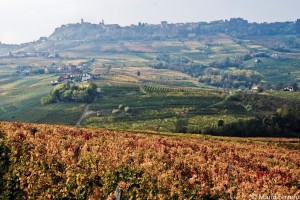
From La Morra, driving through the trunk road for some 7 km, you can reach Cherasco, a city we highly recommend because in its centre you can find real art and cultural jewels. A palace that cannot be missed is Palazzo Salmatoris, location of prestigious international art exhibitions, as well as the ancient tower, the arcades, Saint Peter’s Church, with an amazing façade which is like a “museum” thanks to the Roman plates and decorative fragments from the nearby Roman city of Pollenzo (Pollentia). One must also try the famous “Baci di Cherasco” (the Cherasco kisses), traditional sweets of the city. However, the most enchanting discovery is represented by the facades, the gardens and the colours of the houses in the city centre that you must admire with a slow walk, letting you get transported by sounds, perfumes and emotions that this little corner can evoke. A stroll along the bastions can provide other breathtaking views on the surrounding landscape.
Descending towards the valley and, in the direction of Barolo, we can stop in Novello, agricultural centre located in a panoramic position, a real gateway to Langa. A must-see is the castle with its neo-Gothic style, a project of the architect from Dogliani G.B. Scellino. Continuing towards Barolo: the Castle, which today houses Wi-Mu, the Wine Museum, and also hosts the prestigious Enoteca Regionale del Barolo, the Regional Winehouse of Barolo. The landscape represents an enchanting invitation to stop and take pictures and will stay with us until Monforte d’Alba.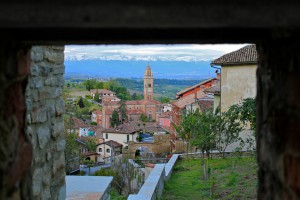
The little city takes its name from the castle surrounded by walls, built in the Early Middle Ages on the top of the hill and that, in 1028, according to the historians Glabro and Landolfo Seniore, was taken by force by the soldiers sent by the Archbishop of Milan, Ariberto d’Intimiano, to repress the Catharism, a movement which spread there involving the feudatories. The inhabitants of Mons Fortis, were made prisoners, brought to Milan and then forced to choose between forswear or stake. The majority, coherent to its principles, chose the stake. We can suppose that the name Monforte, which can be found among the place names of Milan, can be connected to this incident. After several other events, the village became, in 13th century, a feud of the marquises Scarampi del Cairo. In 1703, it was conquered by Savoy troops and thus annexed to the Kingdom of Piedmont and Sardinia.
The current Palazzo Scarampi was built by the noble Del Carretto family after 1706 where once there was a manor house, and it was then restored in 1833. The historical core of Monforte, with a fan shape and perched around the ancient bell tower (the remains of the ancient parish church), vibrates with new life after the recent renovation works which affected several noble and bourgeois palaces. A stroll along its narrow and steep medieval streets, a stop in one of its food courts or hotels, show how this centre of Langa, already famous in the second half of the 1900s for its gastronomy, has been able to give value to its historical centre with great care to the restoration works and the functional rescue of its buildings. A part of the square of the historical heart of Monforte, a little coliseum with perfect acoustics, is used as auditorium and it is named after the famous pianist who played here during its opening in the summer of 1986. In summer, it hosts many events such as jazz concerts, theatre shows and movies projections. In the wide municipal territory you cannot forget to visit the little hamlet of Perno and the little Romanesque church of Saint Stephen.
Proceeding in the direction of Monchiero, let’s continue until Dogliani, the last stop on this tour to discover some of the most enchanting villages of the Barolo Langhe. Today, Dogliani is a densely populated centre that clearly shows the mark of one of its “sons” the eclectic Gian Battista Scellino. In the districts of the hamlet and the castle, a visit allows us to discover interesting corners and buildings without forgetting that we are in the areas dedicated to Dolcetto production (Dolcetto di Dogliani D.O.C.G.) and that in the farms around San Giacomo, Luigi Einaudi, first president of the Italian republic, grew his strong love for the land of its origins.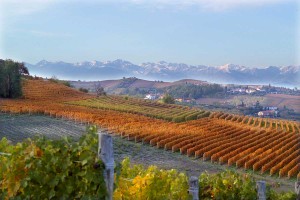
Wine Cellars Along the Itinerary
Castello di Verduno
, Via Umberto I, 9, Verduno CNAlessandria Fratelli
, Via Beato Valfré 59, Verduno CNMarziano Abbona
, Borgata San Luigi 40, Dogliani CNCadia
, Strada Roddi – Verduno, 58, Roddi CNRocche Costamagna
, Via Vittorio Emanuele, 8, La Morra CNMauro Molino
, Frazione Annunziata Gancia 111A, La Morra CNBel Colle
, Fraz. Castagni, 56, Verduno (CN)Agricola Gian Piero Marrone
, Frazione Annunziata 13, La Morra CNNegretti
, Frazione Santa Maria, 53, Località Peso, La Morra CNTenuta L’Illuminata
, Località Sant'Anna 30, La Morra CNBottega del Vino Dogliani
, P.zza San Paolo, 9, Dogliani CNBosco Pierangelo
, Borgata Boiolo, 1, La Morra CNDosio Vigneti
, Regione Serradenari 6, La Morra CNI Brè
, Borgata Breri, 39, Verduno CNDiego Morra
, Cascina Mosca 37, Verduno CNOlivero Mario
, Via Fontanassa, 18, Roddi CNCiabot Berton
, Frazione Santa Maria 1, La Morra CNEnzo Boglietti
, Via Fontane 18/A, La Morra CNAurelio Settimo
, Frazione Annunziata, 30, La Morra CNCrissante Alessandria
, Borgata Roggeri, 44, La Morra CNMoscone
, Regione Cerreto 2, La Morra CNPoderi Luigi Einaudi
, Borgata Gombe, 31, Dogliani CNPlaces to Eat Along the Itinerary
Castello di Verduno
, Via Umberto I, 9, Verduno CNAgricola Gian Piero Marrone
, Frazione Annunziata 13, La Morra CNLa Crota – restaurant and guesthouse
, Via Fontana, 7, Roddi CNHotel Restaurant I Castelli
, C.so Torino 14, Alba CNAccommodation Along the Itinerary
Castello di Verduno
, Via Umberto I, 9, Verduno CNAlessandria Fratelli
, Via Beato Valfré 59, Verduno CNHotel Langhe
, Strada Profonda, 21, Alba CNRocche Costamagna
, Via Vittorio Emanuele, 8, La Morra CNTenuta L’Illuminata
, Località Sant'Anna 30, La Morra CNLa Crota – restaurant and guesthouse
, Via Fontana, 7, Roddi CNDosio Vigneti
, Regione Serradenari 6, La Morra CNCiabot Berton
, Frazione Santa Maria 1, La Morra CNHotel Restaurant I Castelli
, C.so Torino 14, Alba CNCrissante Alessandria
, Borgata Roggeri, 44, La Morra CNPoderi Luigi Einaudi
, Borgata Gombe, 31, Dogliani CNArborina Relais
, Frazione Annunziata 27/B, La Morra (CN)




